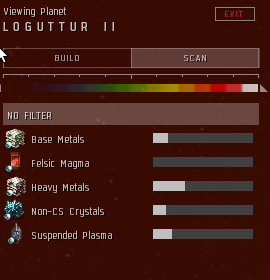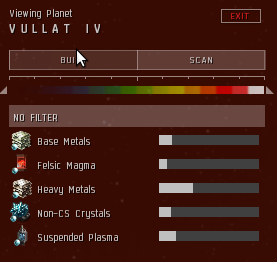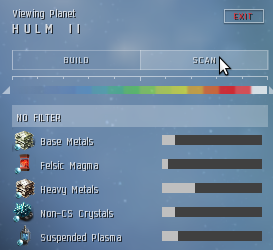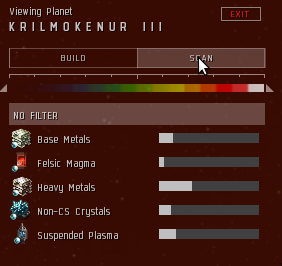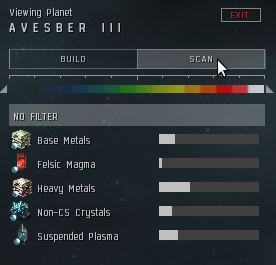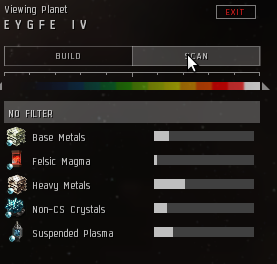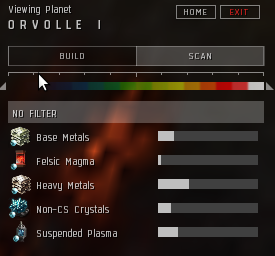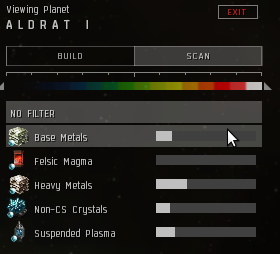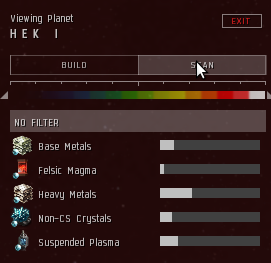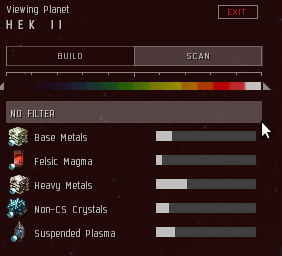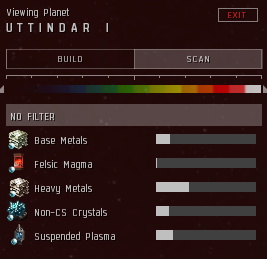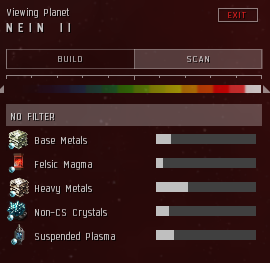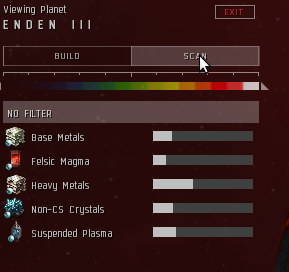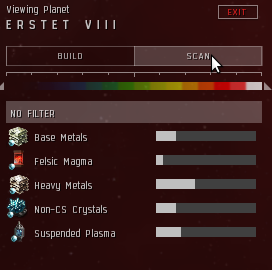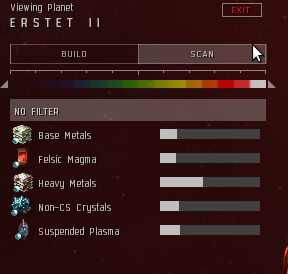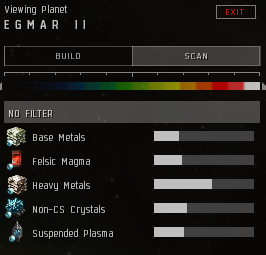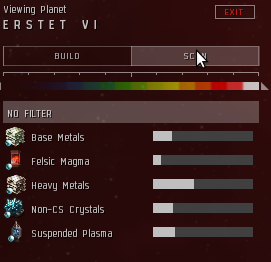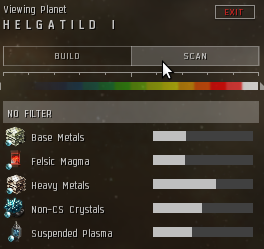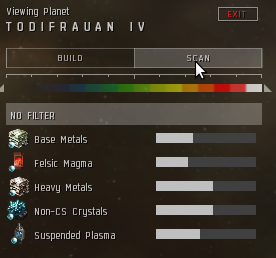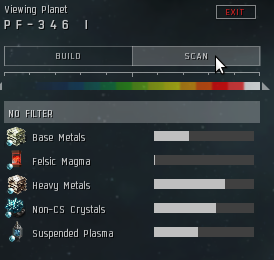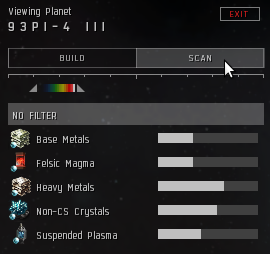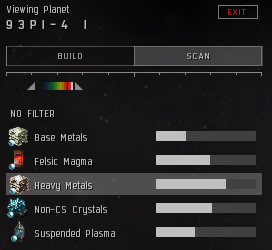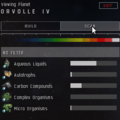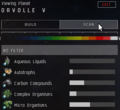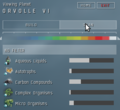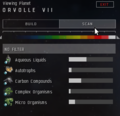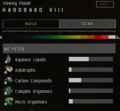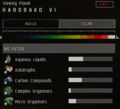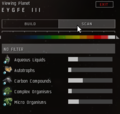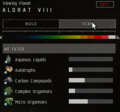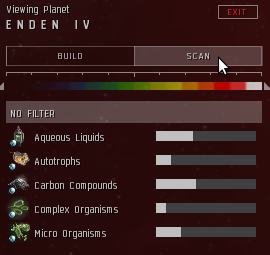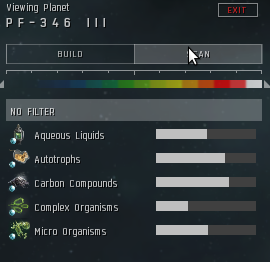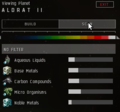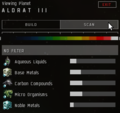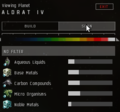More actions
Dierdra Vaal (talk | contribs) |
|||
| Line 18: | Line 18: | ||
(I can only conjecture that Wormholes are similar to 0.0, and likely the higher the class, the better.) | (I can only conjecture that Wormholes are similar to 0.0, and likely the higher the class, the better.) | ||
'''Note:''' these distributions were collected on Singularity server on 2010 May 9, so they might not be valid when Tyranis goes live on Tranquility. | |||
== Lava == | == Lava == | ||
| Line 112: | Line 112: | ||
While clearly low sec and 0.0 will get you generally better results, there are also some gems in High Sec just waiting to be discovered, depending on the products you want to produce. | While clearly low sec and 0.0 will get you generally better results, there are also some gems in High Sec just waiting to be discovered, depending on the products you want to produce. | ||
= Resource Abundance by Planet Type = | = Resource Abundance by Planet Type = | ||
Revision as of 10:12, 20 May 2010
So now it is time to shop for a suitable planet. You have read up on what is made out of what on the Planetary Industry page, and you have decided to make something. Now you need to find one or more planets that will keep your assembly line going. As you can expect, the abundance of resources is affected by the Security Status, but this is not the only consideration. If you wanted to make make a whole product chain on one planet, you need to look at the mix too.
Resource Abundance by Sec Status
However, to start off, let us make this simple and look at the abundance of something that will always require more than one planet, which means you can focus on just the one resource. Lava planets are the only source of Felsmic Magma, which is processed into Silicon. Here is a survey of various lava planets of different security levels.
In High Sec, you will note that Loggutur II and Aldrat I are singularly poor examples of Lava planets, having pretty much no Felsmic Magma at all, while Vullat IV is a rather good Lava Planet, having deposits that rival alot of lower security systems in the High Sec class. In any case though, you are not very likely to find any Lava Planets with huge supplies of Felsmic Magma, but if you look around, you can find some fairly decent ones.
Moving to Low Sec, we see Erstet VIII, which does not do any better abundance than Vullat IV, but has all the dangers of Low Sec. On the other hand, Erstat II has about double the abundance of the high sec systems. However, if we are going to dabble around in low sec, we might as well go all-in and jump to Egmar, Helgatild, or Todifrauan.
Finally, we could move into 0.0, but be careful (from being killed obviously), but also to avoid planets like PF-346 I, where we can find all the dangers of 0.0, and an abundance that is half or less of many High Sec planets. On the other hand, we could strike it lucky and find 93PI-4 I where Felsmic Magma is greater than half-way across the scale. Likely there might even be some planets that are even better.
(I can only conjecture that Wormholes are similar to 0.0, and likely the higher the class, the better.)
Note: these distributions were collected on Singularity server on 2010 May 9, so they might not be valid when Tyranis goes live on Tranquility.
Lava
1.0
0.9
0.8
0.7
0.6
0.5
0.4
0.3
0.2
0.1
0.0
Temperate
Temperate planets are the only place you can find Autotrophs, from which you can make Industrial Fibers. As you can see, we do have a bit of variation, but our prospects seem better for these than Felsmic Magma, particularly since Temperate planets are somewhat more common than Lava planets. Orvolle IV is not a very good planet at all, but Orvolle V, Hardbako VI, Aldrat VIII or Eygfe III would be good places to setup for High Sec Industrial Fiber production.
As can be expected, moving into low sec or 0.0 improves the results, with a very impressive yield in PF-346 III (in comparison to the improvement we saw in Felsmic Magma.)
Hi Sec
Looking at the Temperate distributions in Orvolle (0.7) shows how you must base you decision on your target product:
Let us check out some more locations in High Security space: Hardbako (0.7), Eygfe (0.7) and Aldrat (0.6)
Low Sec and 0.0
Ok, our processors are not really running at full capacity on Orvolle V, so let's try moving to Low Sec, for example Enden (0.4). Clearly we are getting more Autotrophs, but the distribution of other products is similar to some of our high sec examples.
While clearly low sec and 0.0 will get you generally better results, there are also some gems in High Sec just waiting to be discovered, depending on the products you want to produce.
Resource Abundance by Planet Type
We know that you can get some resources on only one planet type, and that there are other resources that appear on multiple planet types. However, are some of the planet types better for some resources?
Aqueous Liquids / Water
Summary: Ice, Oceanic, Storm; Selected Temperate
Let us look at the question of Aqueous Liquids (which produce Water). From the Planet page we know that this resource appears on Gas, Ice, Oceanic, Storm, and Temperate worlds. Intuitively, we would expect Oceanic and Ice worlds to be heavily biased toward watery stuff, but let us look at whether this bears out in reality. (We already know from the paradox that is Aldrat VIII (no water, teaming with life) that Temperate planets are not guaranteed to have very much water at all.)
Scanning the samples below, we find that Ice, Oceanic, and Storm worlds do seem to be good sources. However, Temperate planets sometimes have amazing supplies, and sometimes really bad abundance. These latter cases are easily identified by the high amount of land mass visible on the Temperate planet.
Autotrophs (Industrial Fibers)
Summary: Temperate
This one is simple. They can only be found on Temperate worlds, however if looking in High Sec, shop for your world a little carefully.
Base Metals (Reactive Gas)
Summary: Barren, Gas, Storm
These can be found on Gas, Storm, Barren, Plasma, and Lava Planets, but the best abundance in our sample is on Barren, Gas, and Storm. However, none of them give really horrible abundances.
Carbon Compounds (Biofuels)
Summary: Temperate, Barren; Selected Oceanic
These can be found on Barren, Temperate, and Oceanic worlds. There are pretty good yields on all three, but the most consistent abundances are on Temperate. However, Oceanic worlds have the variability seen in Aqueous Liquids on Temperate worlds, so you could get fantastic abundance, or very little.
Complex Organisms (Proteins)
Summary: Selected Oceanic and Temperate.
These can be found on Temperate and Oceanic worlds. Both have rather variable abundances, so choose carefully.
Felsic Magma (Silicon)
Summary: Lava
This can only be found on Lava worlds, but the high sec survey suggests that the best option might be start shopping in Low Sec or 0.0 if you want to get decent yields.
Heavy Metals (Toxic Metals)
Summary: Ice, Lava
These can be found on Ice, Lava, and Plasma worlds, but the best yields seem to be on Ice worlds.
Ionic Solutions (Electrolytes)
Summary: Selected Storm
These can be found on Gas, and Storm worlds, but Storm worlds seem to have a better abundance. Though the Gas abundance is not too bad.
Micro Organisms (Bacteria)
Summary: Oceanic, Barren; Selected Temperate
These can be found on Ice, Barren, Temperate, and Oceanic worlds. THe best abundances seem to be on Oceanic and Barren, with Temperate having a high variability giving almost nothing or very good.
Noble Gas (Oxygen)
Summary: Gas, Storm
These can be found on Gas, Ice, and Storm worlds. While Ice worlds give OK yield, Gas and Storm worlds seem to give the best abundances.
Noble Metals (Precious Metals)
Summary: Plasma
These can be found on Barren, and Plasma worlds, but Plasma worlds give somewhat better abundances.
Non-Cs Crystals (Chiral Structures)
Summary: Lava
These can be found on Lava, and Plasma worlds, but Lava worlds seem to have somewhat better abundances.
Planktic Colonies (Biomass)
Summary: Ocean, Ice
These can be found on Ice and Ocean worlds, in about equal abundances.
Reactive Gas (Oxidizing Compound)
Summary: Gas
This is only available on Gas worlds, and as usual to get decent abundances, you have to look into visitting Low Sec.
Suspended Plasma (Plasmoids)
Summary: Storm, Lava
This can be found on Storm, Lava, and Plasma worlds. Ironically, Storm and Lava worlds seem to have much better abundance of this than Plasma worlds.
Table of Resource Abundance by Type
| Type | Examples |
|---|---|
| Barren |
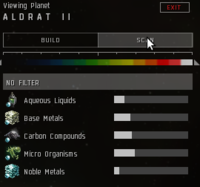 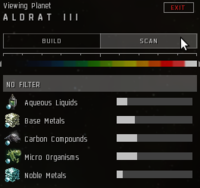 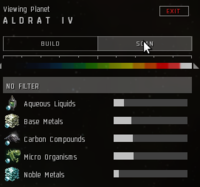
|
| Gas |
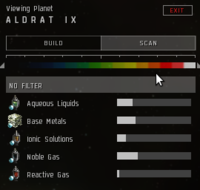 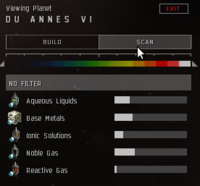 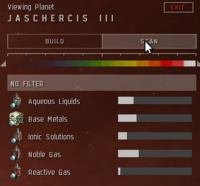 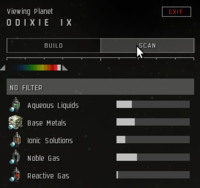
|
| Ice |
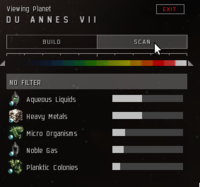 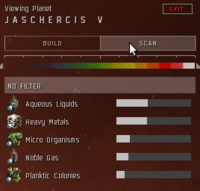 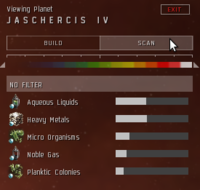
|
| Lava |
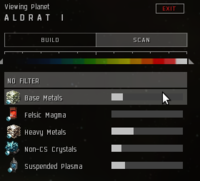 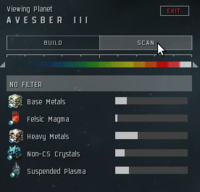 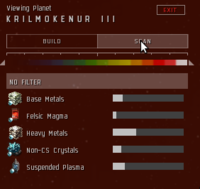
|
| Oceanic |
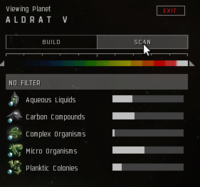 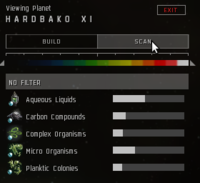
|
| Plasma |
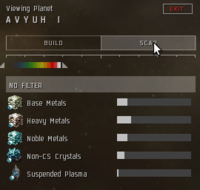  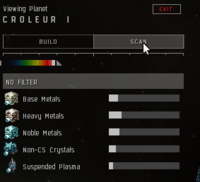 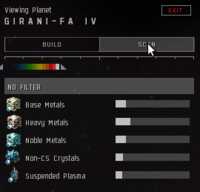
|
| Storm |
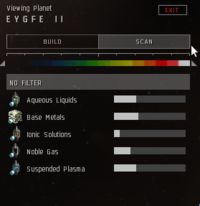 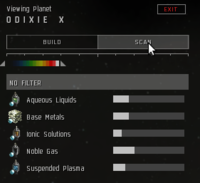 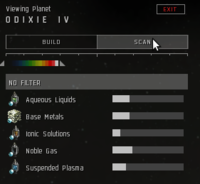
|
| Temperate |
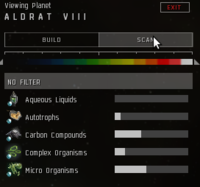 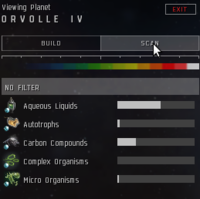 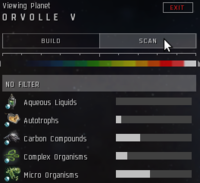 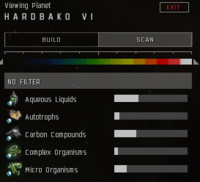 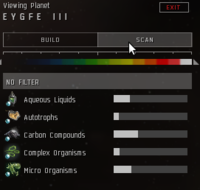
|
Resource Mixes
Moving on to the more complicated question of looking at resource mixtures, we now consider the possibility of not just feeding other producers of the higher levels of production with raw materials, but trying to make something completely ourselves, preferably on one planet. We know from the Planetary Commodities page that there are some planets that can completely make a particular product. For example,
- Livestock are made from Biofuels (made from Carbon Compounds) and Proteins (made from Complex Organisms). Both of these could be found on Oceanic and Temperate planets. Looking at the abundances, both are fairly variable, and so it bears some work hunting for one with a balance of both. The sampling on 0.0 suggests that on Oceanic worlds one is more likely to hit Carbon Compounds being off the chart with decent Complex Organisms than vice versa.
- Test Cultures come from Water and Bacteria, so Barren, Ice, Oceanic or Temperate planets could produce these completely.
- Nanites come from Micro Organisms and Base Metals, a combination only available on Barren worlds.
Note that Eygfe III would be a good planet to produce Test Cultures, since it has equal parts Micro Organisms (makes Bacteria) and Aquaeous Liquid (makes Water), meaning that you are not filling your storage with extra stuff you do not need. This would of course depend on the exact distribution of those two resources as well as their abundance. If we found a planet that has 30% Aqueous Liquids, and 30% Micro Orgasms, this is a good choice. However, what if we found a planet with 30% Aqueous Liquids and 40% Micro Organisms. If we are willing to collect the excess Micro Organisms on a regular basis, we can produce the Test Cultures, and have a small amount of extra revenue selling Bacteria to producers of Nanites, sited on Barren worlds where the abundance of Micro Organisms is less than on the Oceanic world we chose. (We obviously would not be selling to people on Aldrat II, III, or IV, who have chosen a good planet for making Nanites (equal quantities of Micro Organisms and Base Metals), threatening to make this an appallingly poor teaching example.)

